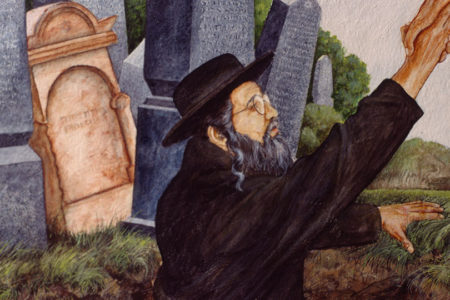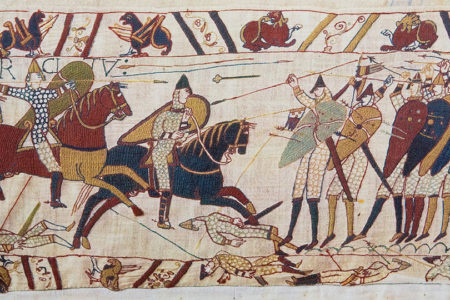Jews Who Made a Difference
Compiling listings of Jewish people who have added immeasurably to the betterment of humanly is a daunting task Jews have contributed constructively to virtually every significant area of human endeavor. Golda Meir, Chaim Potok, Yitzhak Pearlman, George Gershwin, Sandy Koufax—these are among the familiar names from the worlds of music, sports, and politics that illustrate the range of Jewish influence touching our lives daily. Lorna Simcox has compiled brief biographies of a few Jewish people who have made a difference in the lives of millions of us.—The Editor
Justice Louis D. Brandeis (1856–1941) was called the “people’s attorney” because of his concern for human rights and the public interest. He secured low-cost life insurance for workers in Massachusetts, blocked railroad monopoly in New England, and battled for a shorter workday and a minimum wage for working women. In 1916 he was appointed to the United States Supreme Court by President Woodrow Wilson and became the President’s trusted advisor on antitrust and financial legislation, including the Clayton Anti-Trust Act and the Federal Trade Commission Act. Brandeis University in Waltham, Massachusetts, was named in his honor.
Benjamin Disraeli, Earl of Beaconsfield (1804–1881), was a noted British statesman and author. He was leader of the House of Commons, Prime Minister of England in 1868, and a key advisor to Queen Victoria from 1874 to 1880. Creator of the modern Conservative Party, Disraeli spearheaded the passage of factory acts to prevent the exploitation of labor and two trade acts that clarified the legal position of the trade unions. In 1875 he engineered the British government’s purchase of Egypt’s shares in the fledgling Suez Canal and in 1878 played a key role in ending the war between Russia and Turkey. After his burial, Queen Victoria herself laid a wreath upon the grave of her favorite minister.
Paul Ehrlich (1854–1915), a German medical researcher, shared the Nobel Prize for medicine in 1908 for his work on immunity. He is considered the father of immunology for his research into bacterial toxins and poisons, such as snake venom, and the neutralizing antibodies formed in the serum of animals after immunization. He also founded modern hematology and discovered “vital stains,” by which tissues in living animals are colored without any poisonous effect (e.g., nerve fibers by methylene blue). He also founded chemotherapy, a branch of pharmacology, and revolutionized the treatment of syphilis.
Albert Einstein (1879–1955) was born in Germany and received his doctorate from the University of Zurich in 1905. He published three theoretical papers that were of paramount importance to the development of modern physics. He created the special and general theories of relativity and what was a revolutionary hypothesis concerning the nature of light. In 1933 he was appointed Director of the Kaiser Wilhelm Institute for Physics in Berlin, and in 1922 he won the Nobel Prize in physics. However, when Hitler came to power, Einstein immediately left Germany and took a position at the Institute for Advanced Study in Princeton, New Jersey. He helped alert President Franklin Roosevelt to the likelihood that Germany was building an atomic bomb. However, he played no role in making the American bomb and worked for international disarmament. Einstein is probably the best-known scientist of the 20th century.
Joseph Erlanger (1874–1965), an American physiologist, shared the Nobel Prize in 1944 for his work on the functional differentiation of nerves. His pioneering experiments led to the modern view that conduction in myelinated nerve fibers is not continuous but takes place in jumps. His earlier work involved blood circulation and conduction in the heart. He invented a graphic method for measuring blood pressure and studied the mechanism of production of sounds used in measuring blood pressure by the auscultatory (listening) method.
Casimir Funk (1884–1967), a chemist, showed in 1912 that beriberi could be cured in pigeons by feeding them a concentrate (later known as vitamin B, or thiamine) made from rice polishings. He identified the curative substance as an amine (a type of nitrogen containing compound) and proposed it be called “vitamine” for “vital amine.” This discovery led Funk and his colleague, British biochemist Sir Fredrick Hopkins, to conclude that other conditions were caused by diets deficient in these “necessary factors” called “vitamines” (the final was later dropped). In the early days of vitamin research, letters were assigned to the vitamins, categorizing them according to their function. Although later research produced scientific names, they are still best known by their letters.
Waldemar Mordecai Haffkine (1860–1930) was a Ukrainian-born bacteriologist who developed the first effective vaccine against cholera. In 1893 he traveled to India to give inoculations with excellent results. At the request of the British government, he returned to India in 1896 to stem an outbreak of plague, developing an effective vaccine in only three months. The following year Queen Victoria named him Companion of the Order of the Indian Empire and accorded him British citizenship in 1899. In 1925 the Plague Research Laboratory he had founded in Bombay was renamed the Haffkine Institute in his honor.
Isaac Hays (1796–1879), born in Philadelphia, became one of America’s leading ophthalmologists. Besides inventing important ophthalmological instruments, he founded the American Medical Association in 1847 and cofounded the famous Franklin Institute in Philadelphia. He also authored the AMA’s Code of Ethics, which has been adopted by medical societies throughout the United States, and was editor of the American Journal of Medical Sciences, popularly known as the Hays Journal.
Heinrich Hertz (1857–1894), a German-born physicist, verified and extended James Clerk Maxwell’s electromagnetic theory of light. He measured the length and velocity of electromagnetic waves, called Hertzian waves, demonstrating the transverse nature of their vibrations. His extensive experiments unified optics and electromagnetism, paving the way for Marconi’s invention of wireless telegraphy and for radio transmission. The unit used to measure cycles per second of electromagnetic wave motion is called the “hertz” (Hz). Radio broadcast frequencies today are designated in kilohertz on the AM dial and megahertz on the FM dial.
Abraham Jacobi (1830–1919), born in Germany, is the father of American pediatrics. Jacobi, who invented the laryngoscope, an instrument for examining the larynx, established the first clinic for sick children in the United States, and became professor of children’s diseases at New York Medical College in 1860, holding the first chair in that subject founded in the United States. He later taught at New York University (1865–1870) and the College of Physicians and Surgeons of Columbia University (1870–1902). He founded the American Pediatric Society, founded and edited the American Journal of Obstetrics, and in 1868 was elected president of the American Medical Association.
Flavius Josephus (37/38-after AD 93) was born into a priestly Jewish family in Jerusalem. From AD 66 he fought in the Jewish war against Rome but was captured by the Romans and ingratiated himself to Vespasian, who he correctly predicted would become emperor. Josephus then was made a Roman citizen and became a writer, publishing History of the Jewish War in AD 77 or 78 and The Antiquities of the Jews, which uses important sources for the period after 400 BC. His works provide important information on many ancient historical events and on social conditions in the early Roman Empire.
Emma Lazarus (1849–1887) was born in New York City and championed the cause of the oppressed. Although she penned many poems, her best known is The New Colossus, which graces the base of the Statue of Liberty and is now inscribed at Kennedy Airport. Her immortal words, written on a single sheet of paper, express a vision of America that will linger forever in the hearts of its immigrants.
Give me your tired, your poor, your huddled masses yearning to breathe free, the wretched refuse of your teaming shore. Send these, the homeless, tempest tossed, to me. I lift my lamp beside the golden door.
Albert Michelson (1852–1931), a German-born physicist, established the speed of light as a fundamental constant. In 1907 he became the first American ever to receive the Nobel Prize in science. From 1923 to 1927 he was president of the National Academy of Science. In 1920 Michelson became the first person to accurately determine the size of a star by successfully measuring the diameter of the star Betelgeuse (Alpha Orionis). The famous Michelson-Morle experiment (conducted with American chemist William Morley) it is called the most significant negative experiment in the history of science. It resulted in the conclusion that the speed of light plus any other velocity still equal only the speed of light. The result recast physics on-a more refined foundation and led Albert Einstein to propose that the speed of light is a universal constant.
Hermann Minkowski (1864–1909), a German mathematician, created the geometry of numbers. He was one of the earliest mathematicians to realize the importance of Cantor’s theory of sets. Inspired by Albert Einstein’s special theory of relativity, published in 1905, Minkowski came up with the four-dimensional formulation of relativity, which led to the use of the term Minkowski space.
Jonas Salk (1914-) (shown) and Albert Sabin (1906–1993) are credited with virtually eliminating polio around the world. Salk, a New York-born physician and epidemiologist, developed the first vaccine against poliomyelitis, which had reached epidemic proportion almost every year somewhere in the United States since the beginning of the 20th century. In 1952 severe epidemics occurred in Germany, Denmark, and Belgium. By 1954 the Salk vaccine was distributed nationally and almost miraculously reduced the number of cases of polio here and then abroad. Sabin, an American virologist born in Poland, developed the live oral polio vaccine that went into mass use in 1961 and almost completely eliminated the disease around the world.
Haym Salomon (1740–1785) played a major role in helping the young republic of the United States of America survive at its birth. The Polish-born, idealistic financier, who combined wealth with an unselfish loyalty to his principles, was largely responsible for the financial survival of the new nation. His lavish grants for the payment of George Washington’s soldiers and his underwriting of the country’s financial commitments enabled America to weather the storm of those early days. No gain came to Salomon or his descendants, however. So complete was his commitment to the young republic that he was left a ruined man.
Bela Schick (1877–1967) was a Hungarian-American pediatrician who discovered a method for determining susceptibility to diphtheria, an acutely contagious infection that mainly affects children. For many years it was one of the most serious contagious diseases in the world. The Schick test, developed in 1913, gave New York City a remarkable victory in preventive medicine and placed diphtheria in the category of vanishing diseases.
Selman Abraham Waksman (1888–1973) was one of the world’s foremost authorities on soil microbiology. Waksman coined the term antibiotic in 1941, during his extensive study of bacteria-like microorganisms found in soil. Born in the Ukraine, he served as head of the Rutgers University Institute of Microbiology in New Jersey. In 1944 he discovered the antibiotic streptomycin, which became the first effective medicine to control and treat tuberculosis. It earned him the Nobel Prize for medicine in 1952. He also isolated and developed several other antibiotics, including neomycin, that are widely used today to treat infections in humans, animals, and plants.
August Von Wassermann (1866–1925), a German bacteriologist, discovered a universal blood serum test for syphilis. The “Wassermann reaction” and subsequent tests based on its principles are still used today to diagnose the disease before the appearance of physical signs.
Chaim Weizmann (1874–1952), the first president of the State of Israel, was also a renowned chemist. Born near Pinsk in the Russian Pale of Settlement (shtetl), Weizmann studied biochemistry in Berlin, earned his doctorate in Switzerland, and moved to England as a researcher at Manchester University. There, by fermenting a mash of cooked corn, he isolated a starch-decomposing anaerobic organism that produced acetone. The discovery was a boon for the British during World War I, because their munitions required enormous quantities of acetone. Weizmann developed his lab work into a technical process (the first use of a biological process for industrial production other than the manufacture of alcoholic drinks), and plants for the production of acetone were established in India, Canada, and the United States. After the war, they became the Commercial Solvents Corporation and continued manufacturing acetone by the Weizmann process until recently.
Fernand Widal (1862–1929), an Algerian-born Frenchman, impacted the world in 1896 when he discovered a method for diagnosing and preventing typhoid fever. His method became a prototype for diagnosing other communicable diseases and established the basis of cytodiagnosis. His most important contribution was his recognition that sodium in table salt causes water retention. He instituted the now universally used low-salt diet in cases of fluid retention.
Other extremely significant contributions were made by:
Moses Barron, whose 1920 observations on the pancreas led to the discovery of insulin.
Adolph Hannover, Danish pioneer in occupational diseases.
Harold Herschsprung, father of pediatrics in Denmark.
Karl Landsteiner, Nobel Prize winner, and associates Philip Levine and Alexander Wiener, who discovered blood groups, ensuring the reasonable safety of blood transfusions.
Oskar Minkowski, who-demonstrated in 1899 that diabetes is associated with the pancreas.
Tadeus Reichstein, Swiss-born Nobel Prize winner who discovered the drug cortisone.
Moritz Romberg, founder of neuropathology.
Benedict Stilling, who discovered nerve nuclei, which was a turning point in basic neurology.
BIBLIOGRAPHY
A History of the Jews in America by Howard M. Sachar (Alfred A. Knopft, Inc., New York, 1992).
Enyclopaedia Judaica (Keter Publishing House, Ltd., Jerusalem, 1971).
Funk and Wagnalls New Encyclopaedia, Norma E. Dickey, Editor-in-Chief (1986).
New Encyclopaedia Britannica (Encyclopaedia Britannica, Inc., Chicago, 1992).
The Encyclopaedia Britannica (Encyclopaedia Britannica, Inc., Chicago, 1971).
The Jewish Almanac by Richard Siegel and Carl Rheins (Bantam Books, 1980).
Universal Jewish Encyclopedia (Universal Jewish Encyclopedia, Inc., New York, 1943).








